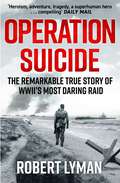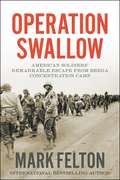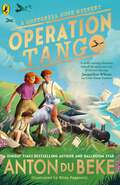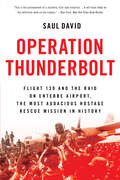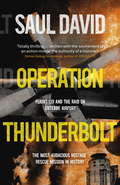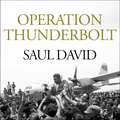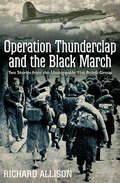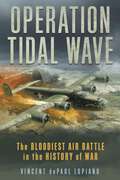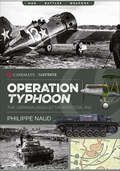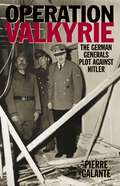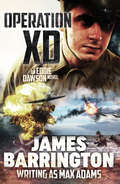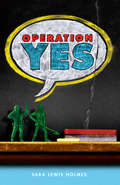- Table View
- List View
Operation Suicide: The Remarkable Story of the Cockleshell Raid
by Robert LymanAt nightfall on December 7 1942, twelve British canoeists arrived by submarine off the coast of France, tasked with infiltrating the dockyards of Bordeaux, and wreaking havoc with the German shipping they found there. Manning fragile 'cockles' through the turbulent waters of the Bay of Biscay, and making an assault on a port bristling with German soldiers ordered to execute any Allied Commando they captured, their prospects looked bleak. It was fully expected that all would die in the attempt. Featuring a cast of characters ranging from Blondie Hasler, the ingenious and courageous leader of the raid, to the Comtesse de Milleville, who risked outrageous danger as she ran a secret resistance network, Operation Suicide is an enthralling account of one of WWII's most iconic missions.
Operation Suicide: The Remarkable Story of the Cockleshell Raid
by Robert LymanAt nightfall on December 7 1942, twelve British canoeists arrived by submarine off the coast of France, tasked with infiltrating the dockyards of Bordeaux, and wreaking havoc with the German shipping they found there. Manning fragile 'cockles' through the turbulent waters of the Bay of Biscay, and making an assault on a port bristling with German soldiers ordered to execute any Allied Commando they captured, their prospects looked bleak. It was fully expected that all would die in the attempt. Featuring a cast of characters ranging from Blondie Hasler, the ingenious and courageous leader of the raid, to the Comtesse de Milleville, who risked outrageous danger as she ran a secret resistance network, Operation Suicide is an enthralling account of one of WWII's most iconic missions.
Operation Swallow: American Soldiers' Remarkable Escape from Berga Concentration Camp
by Mark FeltonThe true and heroic story of American POWs' daring escape from a Nazi concentration camp. In this little-known story from World War II, a group of American POW camp leaders risk everything to save hundreds of fellow servicemen from a diabolical Nazi concentration camp. Their story begins in the dark forests of the Ardennes during Christmas 1944 and ends at the Buchenwald Concentration Camp in the spring of 1945. This appalling chapter of US military history and uplifting Holocaust story deserves to be widely known and understood. Operation Swallow provides a historical, first person perspective of how American GIs stood up against their evil SS captors who were forcing them to work as slave laborers. A young GI is thrust into a leadership position and leads his fellow servicemen on a daring escape. It is a story filled with courage, sacrifice, torture, despair, and salvation. A compelling narrative-driven nonfiction book has not been written that takes the reader deep into the dark story of Operation 'Swallow' and Berga Concentration Camp--until now. Written from personal testimonies and official documents, Operation Swallow is a tale replete with high adventure, compelling characters, human drama, tragedy, and eventual salvation, from the pen of a master of the modern military narrative.
Operation Tabarin: Britain's Secret Wartime Expedition to Antarctica 1944-46
by Alan Carroll Stephen HaddelseyIn 1943, with the German Sixth Army annihilated at Stalingrad and Rommel’s Afrika Korps in full retreat after defeat at El Alamein, Winston Churchill’s War Cabinet met to discuss the opening of a new front. Its battles would be fought not on the beaches of Normandy or in the jungles of Burma but amid the blizzards and glaciers of the Antarctic. Originally conceived as a means by which to safeguard the Falkland Islands from Japanese invasion and to deny harbours in the sub-Antarctic territories to German surface raiders and U-boats, the expedition also sought to re-assert British sovereignty in the face of incursions by neutral Argentina. As well as setting in train a sequence of events that would eventually culminate in the Falklands War, the British bases secretly established in 1944 would go on to play a vital part in the Cold War and lay the foundations for one of the most important and enduring government-sponsored programmes of scientific research in the polar regions: the British Antarctic Survey. Based upon contemporary sources, including official reports and the diaries and letters of the participants, Operation Tabarin tells for the first time the story of this, the only Antarctic expedition to be launched by any of the combatant nations during the Second World War and one of the most curious episodes in what Ernest Shackleton called ‘the white warfare of the south’.
Operation Tango: The new mystery adventure from Strictly Come Dancing star Anton Du Beke
by Anton Du BekeSummer, 1941: London evacuees Harry and Rosie Morton are looking forward to a summer exploring the Lancashire coast with their new friends – and learning to tango as a surprise for Mum’s birthday.Until the twins learn two things: their awful cousin, Jasper, is coming to stay.Worse still: Dad is returning to the Western Front.Then a train journey changes everything and suddenly Harry and Rosie find themselves caught up in a treacherous plot. And, when no one believes their story, they realise they must summon all their courage to not only protect the war effort, but save lives closer to home too . . .With time running out, can the twins stop the crooks before it’s too late and have one last dance with Mum and Dad before he leaves for France?
Operation Thunderbolt: Flight 139 and the Raid on Entebbe Airport, the Most Audacious Hostage Rescue Mission in History
by Saul DavidThe definitive account of one of the greatest Special Forces missions ever, the Raid of Entebbe, by acclaimed military historian Saul David.On June 27, 1976, an Air France flight from Tel Aviv to Paris was hijacked by a group of Arab and German terrorists who demanded the release of 53 terrorists. The plane was forced to divert to Entebbe, in Uganda--ruled by the murderous despot Idi Amin, who had no interest in intervening. Days later, Israeli commandos disguised as Ugandan soldiers assaulted the airport terminal, killed all the terrorists, and rescued all the hostages but three who were killed in the crossfire. The assault force suffered just one fatality: its commander, Yoni Netanyahu (brother of Israel's current Prime Minister.) Three of the country's greatest leaders: Ehud Barak, Shimon Peres and Yitzhak Rabin planned and pulled off one of the most astonishing military operations in history.
Operation Thunderbolt: The Entebbe Raid – The Most Audacious Hostage Rescue Mission in History
by Saul David*By the historical consultant to the major motion picture Entebbe*'The definitive work on the subject....This is the achievement of a masterly, first-rate historian' New York Times Book Review'It's a brilliantly orchestrated book, wonderfully rich in detail, but at the same time roaring along at a heart-thumping pace...' Mail on Sunday'A brilliant, breathless account that reads like the plot of an action movie.' Sunday TelegraphThis edition is updated with new material on recent discoveries. On 3 July 1976 Israeli Special Forces carried out a daring raid to free more than a hundred Israeli, French and US hostages held by German and Palestinian terrorists at Entebbe Airport, Uganda. The legacy of this mission is still felt today in the way Western governments respond to terrorist blackmail. Codenamed Thunderbolt, the operation carried huge risks. The flight was a challenge: 2,000 miles with total radio silence over hostile territory to land in darkness at Entebbe Airport in Idi Amin's Uganda. On the ground, the Israeli commandos had just three minutes to carry out their mission. They had to evade a cordon of élite Ugandan paratroopers, storm the terminal and free more than a hundred hostages. So much could have gone wrong: the death of the hostages if the terrorists got wind of the assault; or the capture of Israel's finest soldiers if their Hercules planes could not take off. Both would have been a human and a PR catastrophe. Now, with the mission largely forgotten or even unknown to many, Saul David gives the first comprehensive account of Operation Thunderbolt using classified documents from archives in four countries and interviews with key participants, including Israeli soldiers and politicians, hostages, a member of the Kenyan government and a former terrorist. Both a thrilling page-turner and a major piece of historical detective work, Operation Thunderbolt shows how the outcome of Israel's most famous military operation depended on secret diplomacy, courage and luck-and was in the balance right up to the very last moment.
Operation Thunderbolt: The Entebbe Raid – The Most Audacious Hostage Rescue Mission in History
by Saul David Saul David Ltd'The definitive work on the subject....This is the achievement of a masterly, first-rate historian' New York Times Book Review'It's a brilliantly orchestrated book, wonderfully rich in detail, but at the same time roaring along at a heart-thumping pace...' Mail on Sunday'A brilliant, breathless account that reads like the plot of an action movie.' Sunday TelegraphThis is the true story of the greatest special forces' operation of the 20th Century and the first shot in the West's long war against international terrorism. It is a tale of human drama and unbearable tension in which courage, comradeship, fanaticism, incompetence and luck all play their part.On 3 July 1976 Israeli Special Forces carried out a daring raid to free more than a hundred Israeli, French and US hostages held by German and Palestinian terrorists at Entebbe Airport, Uganda. The legacy of this mission is still felt today in the way Western governments respond to terrorist blackmail. Codenamed Thunderbolt, the operation carried huge risks. The flight was a challenge: 2,000 miles with total radio silence over hostile territory to land in darkness at Entebbe Airport in Idi Amin's Uganda. On the ground, the Israeli commandos had just three minutes to carry out their mission. They had to evade a cordon of élite Ugandan paratroopers, storm the terminal and free more than a hundred hostages. So much could have gone wrong: the death of the hostages if the terrorists got wind of the assault; or the capture of Israel's finest soldiers if their Hercules planes could not take off. Both would have been a human and a PR catastrophe. Now, with the mission largely forgotten or even unknown to many, Saul David gives the first comprehensive account of Operation Thunderbolt using classified documents from archives in four countries and interviews with key participants, including Israeli soldiers and politicians, hostages, a member of the Kenyan government and a former terrorist. Both a thrilling page-turner and a major piece of historical detective work, Operation Thunderbolt shows how the outcome of Israel's most famous military operation depended on secret diplomacy, courage and luck-and was in the balance right up to the very last moment.(P)2015 Hachette Audio
Operation Thunderclap and the Black March: Two World War II Stories from the Unstoppable 91st Bomb Group
by Richard AllisonIn February 1945, the Allies launched Operation Thunderclap, a series of maximum efforts against cities in eastern Germany, partly to pave the way for the Red Army that would soon be overrunning that territory. These deep-penetration raids would tax the bomber crews immensely, as well as bring new devastation to cities yet untouched by U.S. airpower. Two B-17 crew members, a co-pilot and gunner, trained together in Gulfport, MS, and in fall 1944 were assigned to the longest-serving and most decorated U.S. bomb group in England. However, their paths then diverged. The co-pilot flew 31 missions until war&’s end; the gunner was shot down and captured on his very first combat mission. These crew members both lived—one through Thunderclap and one through the Black March—and this is their story: an account of both constant air combat and travail on the ground. This work includes a firsthand view of the bombing of Dresden, perhaps the worst cataclysm inflicted by bombers in the West. The co-pilot participated in these attacks, where he witnessed a city already too far destroyed to expend additional bombs. Meantime the gunner, shot down and parachuting into enemy territory, was taken prisoner by the Germans, and then forced to endure &“The Black March,&” an effort by the Nazis to move all their prisoners beyond the Red Army&’s advancing spearheads. Of 6,000 Allied POWs put on the roads from northern Poland, in a 500-mile, three-month trek, a quarter died due to the elements, disease and starvation. The gunner survived the March, and once the sands ran out for Germany experienced a period in Soviet captivity. During the day he thought their men behaved; but after dark there was chaos as the Red Army wreaked its revenge. This unique book on the Allied air campaign offers new insights into what our fliers truly saw and experienced during the war.
Operation Thunderclap: The Bombing Of Dresden
by LTC Richard A. ConroyPrecision bombing of military targets was a reality in World War II by the end of 1943. By February, 1945, the war in Europe was nearly over. Why, then at that Tate date, was the city of Dresden destroyed by allied firebombing? In addressing this quest ion, the Dresden case study examines the evolution of bombing practices on both sides during the war in Europe. Both British and American bombing policies are scrutinized. Objectives, both military and political served by the Dresden bombing, are explained. Public reaction to the bombings in the U.K. and the U.S. are discussed as well as the reaction of both Governments to those reactions. Finally, the study examines the doctrine of Just War, draws conclusions and provides commentary.
Operation Thunderhead: The True Story of Vietnam's Final POW Rescue Mission--and the last Navy Seal Kil led in Country
by Kevin DockeryThe war was all but over but there was still one battle the United States had to fight. In the last year of the Vietnam conflict, even as American troops were leaving for home, there were still those fighting for their lives: prisoners of war being held in the Communist north. This is the incredible true story of a rescue mission that was classified Top Secret for years Operation Thunderhead. <P><P>The Navy SEALs and the Underwater Demolition Teams who took part knew that if they were captured, they would be killed, tortured, or simply disappear forever. They went in anyway. Here, the details of Operation Thunderhead are revealed?the mission, the materials, and the men who put their lives on the line to save their brothers in arms.
Operation Thursday: Birth Of The Air Commandos [Illustrated Edition] (The U.S. Army Air Forces in World War II #5)
by SSgt. Randy G. Bergeron Herbert A. Mason Jr.Includes 20 IllustrationsOPERATION THURSDAY -- A bold, unconventional use of American air power to support British ground troops in Burma, Operation THURSDAY marked a critical development in the history of modern warfare. On March 5-6, 1944, the Allies conducted an air invasion of Burma, in an attempt to push back the Japanese in the China-Burma-India Theater and re-establish the land route between India and China. U.S. airmen formed a special operations unit--the 1st Air Commando Group--to transport troops to jungle locations and resupply them, often in the line of fire. The remarkable success of this operation lives on, fifty years later, among the elite 1st Air Commando Group--a force committed to meeting the challenge of unconventional warfare any time, any place, anywhere.
Operation Tidal Wave: The Bloodiest Air Battle in the History of War
by Vincent dePaul LupianoOperation Tidal Wave tells the story of the bloodiest air battle in the history of war. It is about 1700 airmen who set out to bomb the oil refineries surrounding the city of Ploesti, Romania, on August 1, 1943. Success, they thought, would be a force in ending the war. Success instead was extremely limited and 500 airmen were killed, wounded, captured, or interned. Negligible damage resulted at the Ploesti refineries, and a few months later they were operating at one-hundred percent capacity. To show the asperity of the raid, five Congressional Medals of Honor were awarded, two posthumously.
Operation Tonga: 6th Airborne Division—June 1944 (Elite Forces Operations Series)
by Jon CookseyThe seizure of Pegasus Bridge by six glider borne platoons of the Oxfordshire and Buckinghamshire Light Infantry under Major John Howard very early 6th June 1944, is one of the better-known stories of D-Day. Landing just yards from vital bridges over the River Orne and the Caen Canal near Bnouville, Howard's men took and held the bridges in a remarkable coup de main operation with minimal casualties. The 7th Parachute Battalion dropped in soon afterwards to relieve Howard's men and the action remains, by any standards, a remarkable feat of arms. But it was only one act in a much grander production put on by 6th Airborne Division that night to secure and protect the eastern flank of the Allied landings inland from Sword, the British landing beach. Key bridges over the Dives had to be blown to foil possible German counter attacks and to north east, at Merville, a battery of guns which the allied planners thought could wreak havoc on the beaches and ships at sea, had to be eliminated. The task fell to the men of the 9th Parachute Battalion, whose actions in assaulting the Merville Battery became another D-Day epic - but for very different reasons.
Operation Typhoon
by David StahelIn October 1941 Hitler launched Operation Typhoon the German drive to capture Moscow and knock the Soviet Union out of the war. As the last chance to escape the dire implications of a winter campaign, Hitler directed seventy-five German divisions, almost two million men and three of Germany's four panzer groups into the offensive, resulting in huge victories at Viaz'ma and Briansk - among the biggest battles of the Second World War. David Stahel's groundbreaking new account of Operation Typhoon captures the perspectives of both the German high command and individual soldiers, revealing that despite success on the battlefield the wider German war effort was in far greater trouble than is often acknowledged. Germany's hopes of final victory depended on the success of the October offensive but the autumn conditions and the stubborn resistance of the Red Army ensured that the capture of Moscow was anything but certain.
Operation Typhoon: The German Assault on Moscow, 1941 (Casemate Illustrated)
by Philippe NaudA visual look at the Nazi assault on the Soviet capital in the series that&’s &“a welcome addition . . . targeted at the general World War II enthusiast&” (Globe at War). After the initial successes of Operation Barbarossa, at the end of September 1941, Hitler turned his focus to Moscow, with the unshakeable belief that capturing the capital would knock the Soviets out of the war. On the face of it, it was an unequal matchup in Germany&’s favor, but the picture was, in fact, a great deal more complex; the Germans had suffered very significant losses since the invasion of Russia had begun and had issues with logistics and air support. The Soviets, under the command of Gen. Zhukov, were beginning to be better supplied with reinforcements and were prepared to defend to the death. This volume in the Casemate Illustrated series concentrates on the main German assault of October 1941. Guderian&’s panzer divisions at first made sweeping gains, as they had done so many times before, and large parts of the Red Army were encircled at Vyazma and Bryansk. These successes allowed the Soviets time to regroup, as the encircled armies did not surrender and had to be dealt with. Then, three engagements followed at Mtsensk, Maloyaroslavets and the Mojaisk defense line that proved that the war in the east was not entering its final days, as German high command believed. Illustrated with over 150 photographs, plus profile drawings of tanks, vehicles, and aircraft, this book gives a vivid impression of the situation for both protagonists, and a detailed analysis of the critical days as the fate of Moscow—and perhaps the whole war—hung in the balance.
Operation Underworld: How the Mafia and U.S. Government Teamed Up to Win World War II
by Matthew BlackFor the first time ever the full story of how Charles &“Lucky&” Luciano—the U.S. Mafia boss who put the &“organized&” into organized crime—was recruited by U.S. Naval Intelligence in 1944 to aid the Allied war effort in the U.S. invasion of Sicily that was a turning point in WWII. In 1942, fears were growing that New York Harbor was vulnerable to sabotage. If the waterfront was infested with German and Italian agents, the U.S. Navy needed a secret plan just as insidious to secure it. Naval intelligence officer, Commander Charles Radcliffe Haffenden had the solution: recruit as his own spies, members of La Cosa Nostra. Pier to pier, no one terrified the longshoremen, stevedores, shopkeepers, and boat captains along the harbor better than the Mafia gangs of New York, who controlled the docks in Manhattan and Brooklyn. Haffenden was prepared to make a deal with the devil—the man who put &“organized&” into organized crime. Even from his cell in Dannemora State Prison, former Public Enemy #1, Charles &“Lucky&” Luciano still had tremendous power. Luciano was willing to wield it for Uncle Sam in exchange for a fullpardon. Haffenden, though, wanted something in return—Luciano&’s contacts in Italy to track the Nazis&’ movements. The victorious U.S. invasion of Sicily in July 1943 might have turned out differently without Luciano&’s help.Operation Underworld is a tale of espionage and crime like no other, the unbelievable, first-ever account of the Allied war effort&’s clandestine—and improbably—coalition between the Mafia and the U.S. Government to help the Allies win World War II.
Operation Unleashed: A Romantic Thriller
by Justine DavisHe is determined to protect his new family with the help of his K-9But will it put him in the line of fire? For Drew Kiley, married life isn't what he had in mind. Driven to "I do" by a sense of familial responsibility, he assumes the role of husband to his brother's wife, Alyssa…and the role of father to his nephew, Luke. It seems to be the logical solution in light of his brother's abandonment. But Drew doesn't know the whole truth about his brother's past. A rescue from a canine companion sets Drew and Alyssa on a perilous course of extortion, kidnapping and secrets unveiled. United in their determination to protect Luke, Drew and Alyssa learn to depend on each other. But as tensions escalate, so does a deep undercurrent of desire that casts their marriage in a different light.Read the Cutter's Code series from the beginning: Book 1: Operation Midnight Book 2: Operation Reunion Book 3: Operation Blind Date Book 4: Operation Unleashed Book 5: Operation Power Play Book 6: Operation Homecoming Book 7: Operation Soldier Next Door Book 8: Operation Alpha Book 9: Operation Notorious Book 10: Operation Hero's Watch Book 11: Operation Second Chance Book 12: Operation Mountain Recovery Book 13: Operation Whistleblower Book 14: Operation Payback Book 15: Operation Witness Protection Book 16: Operation Takedown Book 17: Operation Rafe's RedemptionPreviously Published
Operation Valkyrie: The German Generals' Plot Against Hitler
by Pierre GalanteThe bomb that exploded in the "Wolf's Lair"—Hitler's command headquarters—on July 20th, 1944 was the closest any assassination attempt ever came to ridding the world of the Nazis' Führer. Pierre Galante's account of the years that led up to the attempt, and its grim aftermath, offers an illuminating look at how dissent among the German officer corps grew until something had to be done. Conspirator General Adolf Heusinger, who met with Hitler on hundreds of occasions, provides his personal accounts of the disintegrating obedience of the German commanders as the war turned against them. Their plan to kill Hitler, establish a provisional government, and negotiate with the Allies for peace—known as Operation Valkyrie—is described here in depth.
Operation Varsity: The British & Canadian Airborne Assault (Battleground The Rhine Crossing)
by Tim SaundersIn Spring 1945 the outcome of the war was ritually certain but the mighty River Rhine still stood in the way of the Allies. Eisenhowers strategy was to guarantee a crossing in the Ruhr area by allocating the main effort to Montgomerys 21st Army Group. Montys task was to envelope and take out the last German war production and open the way onto the North German Plain.On the morning of 24 March 1945 the Normandy veterans of 6th British Airborne Division were to land just three to six miles in front of XII Corps, within supporting distance of their artillery, with the aim of linking up with the ground forces on day one. First in were the two parachute brigades, who benefited from the numbing effect of the Allied bombardment but by the time 6th Airlanding Brigade came in aboard their gliders, the German anti-aircraft gunners were recovering and, on the DZs, resisting and even counter-attacking the British and Canadian paratroopers.Casualties were heavy, not least because the Airlanding Brigade were gliding in amidst an Armoured kampfgruppe. Despite their presence, the glider infantry of the Ox and Bucks and the Ulster Rifles took their bridges and the Devons fought a desperate battle for the key village of Hammelkeln.By evening, despite heavy losses, General Bolss 6th Airborne Division had linked-up with XII Corps, the airborne objectives had been taken and the gateway onto the North German Plain and final victory was open.
Operation Vengeance: The Astonishing Aerial Ambush That Changed World War II
by Dan Hampton"Operation Vengeance is colorful, intimate, eye-popping history, delivered at a breakneck pace. I loved it." –Lynn Vincent The New York Times bestselling author of Viper Pilot delivers an electrifying narrative account of the top-secret U.S. mission to kill Isoroku Yamamoto, the Japanese commander who masterminded Pearl Harbor. In 1943, the United States military began to plan one of the most dramatic secret missions of World War II. Its code name was Operation Vengeance. Naval Intelligence had intercepted the itinerary of Admiral Isoroku Yamamoto, the Commander-in-Chief of the Japanese Combined Fleet, whose stealth attack on Pearl Harbor precipitated America’s entry into the war. Harvard-educated, Yamamoto was a close confidant of Emperor Hirohito and a brilliant tactician who epitomized Japanese military might. On April 18th, the U.S. discovered, he would travel to Rabaul in the South Pacific to visit Japanese troops, then fly to the Japanese airfield at Balalale, 400 miles to the southeast.Set into motion, the Americans’ plan was one of the most tactically difficult operations of the war. To avoid detection, U.S. pilots had to embark on a circuitous, 1,000-mile odyssey that would test not only their skills but the physical integrity of their planes. The timing was also crucial: the slightest miscalculation, even by a few minutes—or a delay on the famously punctual Yamamoto’s end—meant the entire plan would collapse, endangering American lives. But if these remarkable pilots succeeded, they could help turn the tide of the war—and greatly boost Allied morale. Informed by deep archival research and his experience as a decorated combat pilot, Operation Vengeance focuses on the mission’s pilots and recreates the moment-by-moment drama they experienced in the air. Hampton recreates this epic event in thrilling detail, and provides groundbreaking evidence about what really happened that day. Operation Vengeance includes 30 black-and-white images.
Operation XD (An Eddie Dawson Novel)
by James BarringtonEddie Dawson returns in his most explosive outing yet—a World War II thriller based on true events from the author of Right and Glory and To Do or Die. If an officer wants to talk, something&’s usually wrong. Plucked from his unit, Eddie Dawson knows trouble awaits. The Netherlands is under Nazi invasion from land and sea. Amsterdam is besieged. But the Nazis aren&’t interested only in conquest; they want the enormous Dutch oil reserves for their war effort. Soon Dawson understands what game is afoot: he&’s an explosives expert, and there&’s a load of oil that needs to be destroyed. But can he get there in time—and get out alive? Based on true events, this latest James Barrington WWII thriller is intense and unputdownable, perfect for fans of Iain Gale and Jack Higgins.
Operation XD (Eddie Dawson Novel)
by James BarringtonEddie Dawson returns in his most explosive outing yet.If an officer wants to talk, something’s usually wrong. Plucked from his unit, Eddie Dawson knows trouble awaits.The Netherlands is under Nazi invasion from land and sea. Amsterdam is besieged. But the Nazis aren’t interested only in conquest; they want the enormous Dutch oil reserves for their war effort.Soon Dawson understands what game is afoot: he’s an explosives expert, and there’s a load of oil that needs to be destroyed. But can he get there in time – and get out alive?Based on true events, this latest James Barrington WWII thriller is intense and unputdownable, perfect for fans of Iain Gale and Jack Higgins.
Operation Yes
by Sara Lewis HolmesReady? Line UP! FALL IN! And you'll fall for this timely and generous novel set on an Air Force base during the Iraq War, about an amazing teacher and the students she inspires.No one in her sixth-grade class knows quite what to make of Ms. Loupe, with her short hair, her taped square "stage" on the floor, and the interest in improvisational theatre. After all, their school is on an Air Force base--a place that values discipline more than improv. But her students soon come to love her fresh approach; and when her dear brother goes missing in Afghanistan, and Ms. Loupe herself breaks down, they band together to support their teacher. What starts as a class fundraiser expands into a nationwide effort for all injured troops, and an amazing vision of community and hope.
Operation Zickzack: Eves Krieg – Buch eins, Heldinnen der Special Operations Executive
by Hannah Howe„Eves Krieg“ ist eine Reihe aus zwölf Novellen. Jedes Buch ist circa 20.000 Wörter lang und beinhaltet eine in sich abgeschlossene Geschichte. Der Preis wird für die gesamte Reihe auf ein Minimum gesetzt. Der Handlungsbogen von Eves Geschichte wird am Ende der Reihe beendet. Marseille, Dezember 1942 „Wir stecken in der Klemme“, begann Vincent. „Die Gestapo hat einen britischen Agenten, Codename Zickzack, gefangen genommen. Sie sind wegen seiner falschen Papiere auf ihn aufmerksam geworden, aber sie haben seine wahre Identität noch nicht aufgedeckt. Aber das werden sie. Und er wird reden. Das tun sie alle irgendwann. Und wenn er redet, wird er Geheimnisse enthüllen, die die örtlichen Widerstandsnetzwerke, einschließlich unseres, zerstören werden. Aber es gibt einen Ausweg, über einen Wachmann. Er ist offen für Bestechungen. Wir möchten, dass du dich mit dem Wachmann triffst, ihn bestichst, Zickzack aus dem Gestapo-Gefängnis holst und ihn dann über den Bergpass nach Spanien bringst.“ „Warum ich?”, fragte ich. „Weil du geholfen hast, das Fluchtnetzwerk aufzubauen. Und du kennst die Bergpfade wie deine Westentasche. Außerdem bist du als Frau des respektierten Industriellen Michel Beringar vor jedem Verdacht gefeit.“ Ich sah Michel an. Der strenge Ausdruck auf seinem Gesicht verriet mir, dass er nicht glücklich war. War dies ein zu großes Risiko? Und was die Aussage betraf, dass ich vor jedem Verdacht gefeit war: Die Gestapo verfolgte mich und ließ mein Telefon abhören. Als Kind war ich von zu Hause weggelaufen. Als Teenager hatte ich die Welt bereist und mich irgendwie durchgeschlagen. Als Journalistin war ich Zeugin von Gräueltaten geworden, die im Namen des Faschismus begangen wurden. Als Mitglied der Widerstandsbewegung hatte ich der Angst ins Auge geblickt und sie überwunden. In den letzten 30 Jahren hatte ich mein Leben in vollen Zügen ausgekostet. Ich konnte es schaffen. Aber in dem Moment, als ich zustimm
